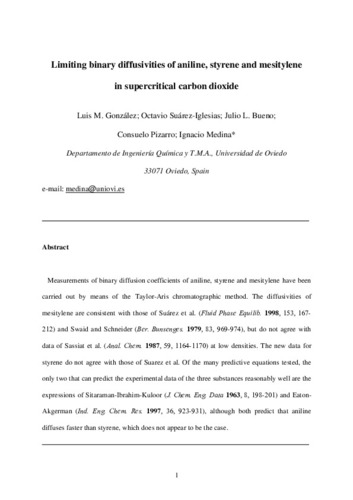Limiting Binary Diffusivities of Aniline, Styrene, and Mesitylene in Supercritical Carbon Dioxide
Fecha de publicación:
Versión del editor:
Citación:
Descripción física:
Resumen:
Measurements of binary diffusion coefficients of aniline, styrene, and mesitylene have been carried out by means of the Taylor−Aris chromatographic method. The diffusivities of mesitylene are consistent with those of Suárez et al. (Fluid Phase Equilib.1998, 153, 167−212) and Swaid and Schneider (Ber. Bunsenges.1979, 83, 969−974) but do not agree with the data of Sassiat et al. (Anal. Chem.1987, 59, 1164−1170) at low densities. The new data for styrene do not agree with those of Suárez et al. Of the many predictive equations tested, the only two that can predict the experimental data of the three substances reasonably well are the expressions of Sitaraman−Ibrahim−Kuloor (J. Chem. Eng. Data1963, 8, 198−201) and Eaton−Akgerman (Ind. Eng. Chem. Res.1997, 36, 923−931), although both predict that aniline diffuses faster than styrene, which does not appear to be the case.
Measurements of binary diffusion coefficients of aniline, styrene, and mesitylene have been carried out by means of the Taylor−Aris chromatographic method. The diffusivities of mesitylene are consistent with those of Suárez et al. (Fluid Phase Equilib.1998, 153, 167−212) and Swaid and Schneider (Ber. Bunsenges.1979, 83, 969−974) but do not agree with the data of Sassiat et al. (Anal. Chem.1987, 59, 1164−1170) at low densities. The new data for styrene do not agree with those of Suárez et al. Of the many predictive equations tested, the only two that can predict the experimental data of the three substances reasonably well are the expressions of Sitaraman−Ibrahim−Kuloor (J. Chem. Eng. Data1963, 8, 198−201) and Eaton−Akgerman (Ind. Eng. Chem. Res.1997, 36, 923−931), although both predict that aniline diffuses faster than styrene, which does not appear to be the case.
DOI:
Colecciones
Ficheros en el ítem





